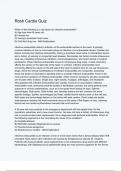Rosh Cardio Quiz
Which of the following is a risk factor for infective endocarditis?
A) Age less than 60 years old
B) Female sex
C) Having a prosthetic heart valve
D) Oral illicit drug use - ANS-Explanation:
Infective endocarditis refers to infection of the endocardial surface of the heart. It typically
involves infection of one or more heart valves or infection of an intracardiac device. Cardiac risk
factors include prior infective endocarditis, having a prosthetic heart valve or intracardiac device,
and a history of valvular or congenital heart disease. Noncardiac risk factors include intravenous
drug use, indwelling intravenous catheters, immunosuppression, and recent dental or surgical
procedures. When infective endocarditis occurs in intravenous drug users, it most commonly
affects the valves on the right side of the heart. In contrast, infective endocarditis most
commonly affects the valves on the left side of the heart in patients who do not use intravenous
drugs. Since the clinical manifestations of infective endocarditis are nonspecific, assessing
these risk factors is important in deciding when to consider infective endocarditis. Fever is the
most common symptom of infective endocarditis. Other common symptoms are also nonspecific
and include chills, malaise, weight loss, night sweats, myalgias, arthralgias, and headache.
Most patients with infective endocarditis have cardiac murmurs on auscultation. Infective
endocarditis most commonly presents acutely in developed countries, but some patients have
subacute or chronic presentations, such as a low-grade fever lasting for days. Splinter
hemorrhages, Roth spots, Osler nodes, and Janeway lesions are less common but more
specific findings. Splinter hemorrhages are linear, reddish-brown lesions seen on the nail bed.
Roth spots are hemorrhagic lesions on the retina with pale centers. Osler nodes are tender
subcutaneous nodules that most commonly occur on the pads of the fingers or toes. Janeway
lesions are non tender erythematous macules that most common
A 35-year-old man presents to the emergency department with low-grade fever, flu-like
symptoms, petechiae, and a new-onset murmur. He does not have a history of intravenous drug
use or previous heart valve replacement. He is diagnosed with bacterial endocarditis. Which of
the following organisms is the most likely the cause of his condition?
A) Candida albicans
B) Methicillin-resistant Staphylococcus aureus
C) Pseudomonas aeruginosa
D) Streptococcus viridans - ANS-Explanation:
Infective endocarditis is an infection of one or more heart valves that is almost always fatal if left
untreated. Most native valve infections are caused by Streptococcus species (S. viridans).
Patients who have prosthetic valve replacements or are intravenous drug users have different
bacteriology, with Staphylococcus epidermidis being the most common organism for the former
, group and Methicillin-resistant Staphylococcus aureus being more common in the latter.
Symptoms of subacute endocarditis can be subtle and nonspecific, including low-grade fever,
anorexia, weight loss, influenza-like syndromes, and pleuritic pain. Patients may also present
with the following classic findings: petechiae, splinter hemorrhages on proximal nail bed, Osler
nodes (painful, red, raised lesions found on the hands and feet), Janeway lesions (non-tender,
erythematous macular or nodular lesions found on the palms and soles of feet), and Roth spots
(retinal hemorrhages with pale centers). Signs of neurologic involvement include embolic stroke
with focal neurologic deficits caused by vegetations breaking off from the valves (most common
neurologic presentation), intracerebral hemorrhage, and multiple microabscesses. The Duke
diagnostic criteria are used to examine both blood cultures and echocardiographic findings to
make a definitive diagnosis of infective endocarditis. In order for the diagnosis of endocarditis to
be made, there must be at least two major Duke criteria present, or one major criterion with
three minor criteria, or five minor criteria present. Major criteria include: (1) two separate positive
blood cultures with microorganisms typical for infective endocarditis and (2) evidence of valvular
lesions on echocardiogram or clearly established new valvular regurgitation. Minor criteria
include: (1) predisposing heart c
A 65-year-old man presents with chest pain, dyspnea, jugular venous distension, and
hypotension. He sustained blunt chest trauma from a motor vehicle accident one hour prior to
arrival. ECG shows electrical alternans. Which of the following is the most likely diagnosis?
A) Acute myocardial infarction
B) Cardiac tamponade
C) Pulmonary contusion
D) Tension pneumothorax - ANS-Explanation:
Cardiac tamponade is the accumulation of pericardial fluid under pressure, usually secondary to
a rapidly-developing pericardial effusion. The increased pressure leads to compression of the
cardiac chambers and decreased systemic venous return and cardiac output. Cardiac
tamponade can be caused by infectious etiologies such as pericarditis, acute bleeding, post-MI
with free wall rupture and trauma. Signs and symptoms include chest pain, hypotension, sinus
tachycardia, elevated jugular venous pressure, muffled heart sounds, narrowed pulse and
pulsus paradoxus (an exaggerated drop in systemic blood pressure with inspiration). ECG may
show electrical alternans, a beat-to-beat alteration in the QRS complex that is caused by the
heart swinging in the pericardial fluid. Though electrical alternans is specific for cardiac
tamponade, it is not sensitive. Chest X-ray may show a widened cardiac silhouette from the fluid
accumulation. Definitive diagnosis can be made with echocardiography, computed tomography,
and cardiac magnetic resonance imaging. Treatment consists of emergent surgery or
pericardiocentesis.
A 34-year-old G1P0 at 26 weeks gestation presents to the office with worsening dyspnea with
activity. She has a history of rheumatic heart disease as a child and has been monitored for mild
mitral stenosis since the age of 12. Which of the following physical exam findings is most likely
to be present?
A) A blowing, high-pitched harsh systolic murmur




